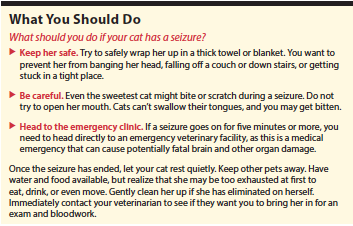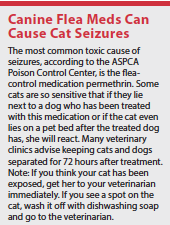In a grand mal seizure, your cat collapses, loses consciousness, may roll or thrash, may urinate and/or defecate, and often vocalizes. Post seizure, there is usually a short period when she will be disoriented, and she will be exhausted once she totally recovers from the seizure. Fortunately, grand mal seizures are uncommon in cats.
Most cats have focal seizures, which are mild in comparison. “I think that seizures in cats can be missed, as they more commonly have focal, not generalized seizures,” says Emma Davies, BVSc, MSc, associate clinical professor of neurology at the Cornell University Hospital for Animals.
Focal seizures involve a conscious cat, but other signs vary dramatically. Some cats simply show unusual twitching of their ears, eyelids, or whiskers. Others may exhibit wild, violent activity, running, crashing into things, and leaping in the air.
Seizures have a wide range of causes. Metabolic conditions such as a liver shunt or hypertension in older cats may contribute to seizures. Toxins are relatively common causes (see sidebar).
One study found that viral encephalitides (diseases caused by inflammation of the brain) like feline infectious peritonitis (FIP) are a common cause of seizures in cats under 3 years of age. In older cats, brain cancer is a common cause.
Diagnosis
 Your veterinarian will do a complete physical exam and take a thorough history, including investigating access to potential toxins, from plants to chemicals. If your cat does not return to totally normal between seizures, causes like a brain tumor or metabolic problem become more likely. A neurologic exam may reveal slight deficits. Bloodwork can reveal low blood sugar or hyperthyroidism. For a definitive diagnosis, your veterinarian may refer you for an MRI or CT scan. Due to the cost, many owners will elect to try treatment without these tests.
Your veterinarian will do a complete physical exam and take a thorough history, including investigating access to potential toxins, from plants to chemicals. If your cat does not return to totally normal between seizures, causes like a brain tumor or metabolic problem become more likely. A neurologic exam may reveal slight deficits. Bloodwork can reveal low blood sugar or hyperthyroidism. For a definitive diagnosis, your veterinarian may refer you for an MRI or CT scan. Due to the cost, many owners will elect to try treatment without these tests.
Treatment
Each cat responds slightly differently to seizure medications. You will need to work with your veterinarian to find the dose and combination of medications that works best for your cat. Phenobarbital, levetiracetam, and zonisamide are common choices.
your veterinarian to find the dose and combination of medications that works best for your cat. Phenobarbital, levetiracetam, and zonisamide are common choices.
Infrequent seizures, such as once every six months, may not require medication. With frequent seizures, however, medications may be needed to break the seizure cycle. Think of a seizure as walking through a field of tall grass. The first time, it is difficult to walk through, but each seizure makes the path more obvious and easier for the next seizure to occur.
Bottom Line
Your cat’s seizure may be an individual event that may or may not recur. A diagnosis of epilepsy means that your cat has recurring seizures. Decisions regarding treatment depend upon the frequency of your cat’s seizures. Remember that a feline seizure can be as simple as an oddly twitching limb.
If you suspect a seizure, immediately start a seizure log in a notebook that lists the date, time of day, and length of seizure. Take a video so that your veterinarian and/or veterinary neurologist can observe the behavior. Write down all potential triggers for the seizure, even things that seem minor. Think of unusual foods or activities. Identifying triggers can help avoid additional episodes. Luckily, most cats who do experience seizures can be managed and live reasonable lives




